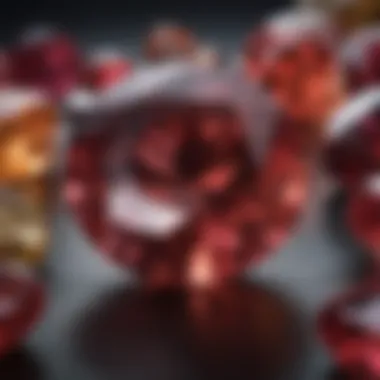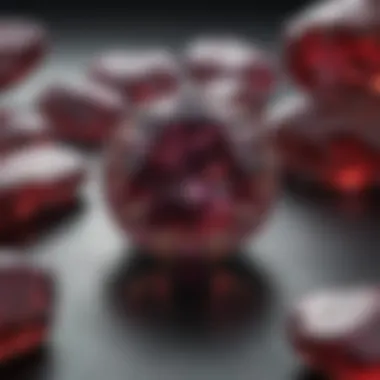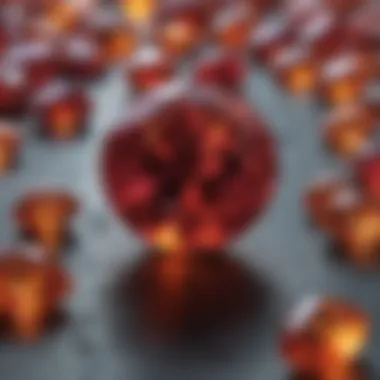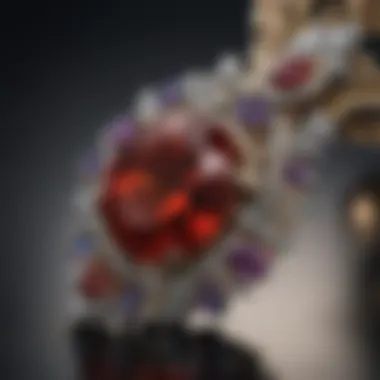Exploring the Birthstone of January 14: Significance and Meaning


Intro
When it comes to birthstones, those shimmering gems seen in jewelry often hold more than just aesthetic value. For individuals born on January 14, a unique gemstone embodies a rich tapestry of history, significance, and intriguing qualities. This piece embarks on a journey through the multifaceted layers of the January 14 birthstone, focusing on its gemstone profile, metaphysical properties, and the deeper meanings it represents across cultures.
Gemstone Overview
Description of the gemstone
The birthstone associated with January 14 is garnet, a vibrant gem known for its deep red hues. However, garnet is not merely about its expected crimson shades; it can be found in various colors ranging from green to orange. This stone’s name is derived from the Latin word "granatum," which means pomegranate—a nod to the fruit's deep red seeds that resemble the gem's rich coloration.
Garnets have been cherished throughout history, believed to adorn warriors and nobility alike, standing as a testament to both beauty and strength. They're not just pretty baubles but symbols of camaraderie, common among soldiers who wore these gems for protection in battle.
Physical properties
Garnet is classified as a silicate mineral and exhibits a cubic crystal system. Its Mohs hardness ranges from 6.5 to 7.5, making it a fairly durable choice, ideal for daily wear in jewelry. Additionally, its ability to refract light gives garnets a brilliant shine that catches the eye—perfect for engagement rings or statement pieces.
"Garnet has been used since antiquity, serving both as a protective talisman and a symbol of love. It combines history with beauty in every facet."
Some specific types of garnet, like the rare tsavorite and demantoid, fetch high prices and are sought after by collectors.
Healing Properties
Metaphysical attributes
Diving into metaphysical beliefs, garnet is often associated with vitality and strength. It is said to revitalize emotions, clear the mind, and foster self-confidence. Those who resonate with garnet often speak of its ability to inspire passion—whether in personal or professional realms. Moreover, garnet is thought to ground its wearer, connecting them to the earth and instilling a sense of security.
Common uses in holistic practices
In holistic practices, garnet is utilized for various healing purposes. Some common applications include:
- Boosting energy levels: Many practitioners recommend garnet for enhancing one's energy, especially in times of fatigue.
- Emotional well-being: Used in meditation, it is believed to help stabilize emotions and promote emotional balance.
- Physical healing: Some alternative healers claim it can aid in detoxification and improve circulation.
Collecting garnet might not only bring beauty to your collection but could also serve as a conduit for emotional healing and revitalization. For gemstone enthusiasts and collectors, understanding the significance of this birthstone can deepen appreciation for its beauty and history.
As we uncover the broader cultural relevance and practical applications of garnet, a picture emerges not just of a stone but of a companion through various facets of life—beautifying, healing, and inspiring.
Preamble to Birthstones
Birthstones carry a significance that resonates deeply with individuals across various cultures and generations. They are not merely gemstones, but symbols steeped in history, emotion, and personal connection. This article serves as a gateway to understanding the intricate world of birthstones, particularly the garnet associated with January, which is celebrated on January 14. Recognizing the importance of the birthstone lays the foundation for appreciating its multifaceted nature.
Understanding birthstones allows us to acknowledge important aspects such as their historical development, cultural variations, and the meanings attached to them. From ancient civilizations who believed gemstones held metaphysical powers, to modern interpretations where they represent personal affiliations and celebrations, birthstones have a rich narrative that deserves exploration.
By delving into this topic, we uncover not only the gemstones' fascinating histories but also how they contribute to personal identity and emotional well-being. For gemstone enthusiasts, collectors, and jewelry designers, recognizing the layered significance of each stone broadens their appreciation and provides insight into their artistry and craft.
Historical Context of Birthstones
Historically, birthstones can be traced back to ancient practices where gemstones were believed to be imbued with mystical properties. The origins of these beliefs are often linked to scriptures, like the Book of Exodus in the Bible, which detailed the twelve stones in the breastplate of the High Priest Aaron, each representing one of the twelve tribes of Israel. This biblical account lays the groundwork for the tradition of assigning specific stones to each month.
In the centuries that followed, various cultures adopted and adapted these associations, each weaving their own beliefs into the tapestry of birthstone history. For instance, the Romans linked their own named gems to the zodiac signs, creating a rich narrative that connected astrological influences to precious stones. On the other hand, cultures in the East, such as India, enhanced this notion with their own beliefs about the healing and protective properties of certain gemstones, leading to the practice of wearing specific stones for beneficial effects.
As trade routes expanded and globalization began, the significance of birthstones continued to evolve, merging different traditions and beliefs about their powers and meanings. Notably, in the 20th century, the National Retail Jewelers Association formally adopted a list of birthstones, standardizing what many view today as the contemporary birthstone tradition.
Cultural Variations in Birthstone Traditions
Birthstone traditions vary significantly across cultures. In many societies, birthstones are considered direct links to an individual's traits, strengths, or destinies. For example, in Western culture, garnet for January symbolizes protection and fidelity, resonating with the idea of grounding oneself in truth and commitment.
Conversely, in Indian culture, each gemstone is also aligned with celestial bodies, believed to bring auspiciousness. The garnet is honored but may not hold the same prominence as in Western traditions. Instead, a stone like ruby may take center stage for those born in July, demonstrating how cultural contexts shape the understanding of gemstones.
"Though cultures differ, the thread that connects them is the universal quest for identity and meaning through the lens of birthstones."
Similarly, African and Middle Eastern cultures also emphasize different attributes in the same stones, sometimes associating them with health, wealth, or spiritual enlightenment. Understanding these cultural variations enriches our appreciation of the garnet and its significance to people born in January, providing a holistic view toward its role in global heritage.
January Birthstone Overview
When we dive into the realm of January birthstones, the first thought that comes to mind is garnet. It’s a jewel with a rich tapestry of history, color, and significance that spans cultures and centuries. Understanding its importance allows enthusiasts and collectors to appreciate not just its physical beauty but also its deeper cultural connections.
Garnet, often presented in deep reds, is more than a mere decoration. For many cultures, it symbolizes protection and guidance. Classically seen as a stone of commitment, garnet nurtures love and devotion. This potential for emotional connection plays a vital role in how individuals view their birthstone, making it much more than just a fancy rock. The importance of garnet as a January birthstone primarily comes from its ability to resonate with various facets of daily life—be it in love, health, or personal growth. Knowing how it relates to January allows us to feel closer to the sentiments of the month.


Moreover, garnet's remarkable versatility means it finds its way into various types of jewelry—from stunning necklaces to elegant rings. This adaptability highlights its ongoing relevance in modern day’s fashion and personal expression.
The Significance of Garnet
Garnet has been esteemed throughout various periods in history. Ancient Egyptians treasured it, believing it brought protection to travelers and warded off negative energies. In medieval Europe, garnets adorned the armor of knights, symbolizing courage and resilience. Today, garnet continues to embody symbols of strength and love.
Garnet’s metaphysical properties are also widely discussed. Many believe it enhances one's passion, motivation, and self-confidence. These attributes make garnet particularly appealing to individuals seeking personal transformations.
Beyond its emotional virtues, garnet is deeply embedded within the earth's geology. Formed under intense pressure, these stones often tell a story of resilience and transformation.
Other Stones Celebrated in January
While garnet holds the title as January’s primary gemstone, it’s worth noting that several other stones also share the spotlight.
- Rose Quartz: Often called the stone of love, it encourages unconditional love and is healing for emotional wounds.
- Amethyst: Known for its calming properties, this vibrant purple stone is believed to aid in clarity and spiritual growth.
- Blue Topaz: Celebrated for its vibrant hue, it symbolizes loyalty, love, and friendship, making it a fitting companion for garnet in this month.
Each of these stones contributes to January's diverse jewelry selections, adding layers of meaning and beauty, thus appealing to a wider audience.
"The celebration of January birthstones goes beyond garnet—each stone adds to its narrative and beauty."
In summary, January stands out through its multiple birthstones, primarily garnet. The stones' historical backgrounds and cultural significance highlight what's truly special about this month. Understanding these elements not only enriches the appreciation of these gemstones but also connects us to a broader human experience.
Scientific Properties of Garnet
Garnet, the esteemed birthstone for those born in January, shimmers with a variety of properties that are not only spectacular visually but also scientifically intriguing. Understanding these properties can enrich one's appreciation of garnet, whether you’re a casual admirer or a dedicated collector. This section delves into the vital characteristics that make garnet a gem of both beauty and geological significance.
Geological Formation
Garnet is a silicate mineral, belonging to a group that encompasses various species, including pyrope, almandine, and spessartine. It forms under high-pressure, high-temperature conditions, mainly in metamorphic rock, but can also be found in igneous formations. The geological processes which lead to the creation of garnet take millions of years. During metamorphism, the intense heat and pressure cause the minerals within the existing rock to rearrange and crystallize into garnet.
It's fascinating to observe that garnets often coexist with other minerals such as biotite and quartz, adding layers of complexity to their formation. The presence of different elements influences the stone's ultimate color and composition.
"The journey of garnet from deep within the Earth to the surface is a testament to the natural forces at work beneath our feet."
Physical Characteristics
When examining garnet, one is struck not only by its beauty but also by its durability. On the Mohs scale, garnet ranks between 6.5 and 7.5, indicating a good level of hardness which makes it suitable for daily wear in jewelry. Its crystal structure is typically dodecahedral, giving it a distinctive geometric appearance.
The luster of garnet ranges from vitreous to resinous, depending on the specific variety. This variation adds to its visual appeal as it reflects light in captivating ways. Moreover, garnets are not prone to cleaving, which further enhances their resilience, making them suitable for various types of jewelry items, from rings to pendants.
Color Varieties and Their Significance
Garnet is renowned for its wide array of colors, stemming from the presence of different trace elements during its formation. The most recognized color is red, often associated with love and passion, but garnets can also be found in shades like green, yellow, and orange.
- Red Garnet (Almandine) - Often symbolizes strength and protection.
- Green Garnet (Tsavorite) - Linked to healing and prosperity.
- Yellow Garnet (Mali) - Often signifies intelligence and insight.
- Color-change Garnet - Unique in its ability to display different colors under different lighting conditions, used often to symbolize adaptability and change.
These color distinctions not only determine the garnet's value but also hold significance across different cultures and traditions, which enhances the stone's allure and desirability.
Metaphysical Attributes of Garnet
Garnet, the birthstone for January, isn't just revered for its visual allure but is also steeped in profound metaphysical attributes that many gemstone enthusiasts and spiritual seekers value deeply. Understanding these characteristics can offer insight into how garnet can manifest real benefits in daily life as well as in more specialized practices such as crystal healing and energy therapies.
Healing Properties and Applications
One of the most notable claims regarding garnet is its healing properties. Many folks believe that garnet fosters physical, emotional, and spiritual healing. It’s often said to encourage vitality and rejuvenation—qualities that resonate particularly well during the chill of winter when energies can feel depleted. Some assert that wearing garnet can help stimulate the body’s metabolism, regulate blood flow, and even alleviate issues related to the heart.
Moreover, garnet’s reputed ability to transform energy is something that practitioners often highlight. It’s used in healing circles as a stone that can absorb negative energies and transform them into positive ones. This transmutation can play a key role in enhancing personal power and confidence, aiding one’s journey towards self-awareness and stability.
- Common Applications of Garnet in Healing Practices:
- Meditation: Holding or placing garnet on the body during meditation may amplify one's focus and grounding.
- Crystal Grids: Used with other stones, garnet can enhance the overall energetic field created.
- Jewelry: Wearing garnet as a bracelet or necklace keeps its energies in close proximity, believed to provide continuous support.
Astrological Associations
Garnet also holds unique associations within the astrological realm, tying directly to individuals born in January. Astrologers often link garnet with the planet Mars, emphasizing its energetic qualities. The implication here is that garnet can enhance determination, bravery, and the ability to pursue goals without wavering. Each zodiac sign boasts various compatible stones, and for Capricorns, the connection to garnet is particularly profound.
Practitioners often suggest that this relationship enables Capricorns to access their inner strength and tackle challenges head-on.
- Notable Astrological Associations with Garnet:


- Capricorn: Stability and ambition.
- Aquarius: Reminds of personal freedom.
- Aries: Amplifies courage and action.
Garnet in Energy Work
The subject of energy work often intersects handily with garnet's rich properties. For those steeped in healing practices, garnet is seen as more than just a beautiful stone; it is a tool that can aid in harmonizing body energies. Practitioners often utilize garnet during energy work for its ability to clear blockages and encourage smooth energy flow throughout the body.
Many believe that garnet resonates with the root chakra, grounding individuals and connecting them to the Earth. This grounding energy is crucial for practitioners searching to balance spiritual pursuits with practical, earthly matters.
- Ways Garnet is Used in Energy Work:
- Chakra Work: Placing garnet on the root chakra can enhance feelings of stability and safety.
- Aligning the Aura: Garnet may help restore balance and vitality to the aura.
- Visualization Practices: Imagining the rich colors of garnet can consolidate focus and affirm intentions.
"Garnet is not merely a gemstone; it is a gateway to unlocking our potential and bringing forth the changes we seek in life."
In summation, garnet encompasses a wealth of metaphysical attributes that extend far beyond its physical form. From its healing properties to its astrological connections and its application in energy work, garnet invites individuals to explore dimensions of their personal journeys.
By delving into its myriad uses, one may find that garnet holds the key to spiritual awakening and personal empowerment.
Garnet in Jewelry Design
Garnet holds a special place in the realm of jewelry design, acting as both a striking focal point and a symbol of deeper meanings. Its rich, deep hues are more than just eye-catching; they carry historical and cultural significance that has made garnet a preferred gemstone for centuries. The next parts will delve into the rich tapestry of garnet’s historical usage, the modern styles and trends shaping its place in the market today, and tips for selecting the right garnet jewelry pieces.
Historical Usage in Jewelry
Throughout time, garnet has been a beloved choice in jewelry, revered for its captivating colors that span from vibrant reds to subtle greens. Historically, this gemstone has been associated with nobility and luxury. Ancient Egyptians cherished garnets, incorporating them into elaborate burial jewelry, believing they would provide protection and safe passage in the afterlife. Similarly, during the Middle Ages, garnets were often used to adorn the robes of royalty, symbolizing power and wealth.
Many cultures revered garnet for its supposed metaphysical properties, such as protection from harm and enhancement of one's health. This belief played a significant role in crafting amulets and talismans. Also, artists and jewelers favored garnet, not only for its beauty but also for its comparative durability. In addition, skilled craftsmen could often facet these stones, enhancing their brilliance and making them even more desirable.
Garnet's journey through centuries has been marked by its frequent appearance in various jewelry styles, from ancient Roman cameos to Victorian brooches.
Modern Trends and Styles
In today’s world, garnet jewelry reflects a playful blend of traditional and contemporary design elements. The modern market sees a rise of personalized pieces where garnets are often paired with gold or silver, lending a luxurious touch that appeals to young and sophisticated consumers alike. Designers are embracing minimalistic settings that enhance the garnet’s natural beauty without overshadowing it.
Some current trends include:
- Layered necklaces featuring garnet pendants.
- Statement rings that use garnet in unique, artistic ways.
- Mixed media designs combining garnet with other gemstones or materials like wood or leather for an eclectic approach.
The choice of garnets extends beyond jewelry aesthetics; they resonate with personal symbolism. Many consumers choose garnets to reflect their personality traits like determination and vitality, making them more than just accessories.
Tips for Selecting Garnet Jewelry
Choosing the perfect garnet piece requires some considerations to ensure you’re getting both quality and value for your investment. Here are some tips:
- Examine the color: While garnets can come in various hues, a deep, saturated red is often the most sought after. Look for stones that have a vibrant color without any brownish undertones.
- Check for clarity: Look for inclusions that might detract from the stone’s beauty. A cleaner stone will generally be more valuable.
- Consider the cut: The cut can greatly affect how the garnet sparkles. Ideal cuts will enhance the stone's brilliance and luminosity.
- Choose a reputable seller: Always purchase from trusted jewelers or retailers to ensure the authenticity of the garnet.
"Buying garnet jewelry is not just about the purchase; it's about investing in a piece of history and emotion."
Ultimately, whether for oneself or as a gift, garnet jewelry embodies personal stories and connections that resonate across generations. Each piece, steeped in meaning and beauty, continues to delight and inspire those who embrace its significance.
Caring for Garnet
Caring for garnet is crucial for anyone who appreciates the beauty of this January birthstone. Keeping garnet in good condition not only preserves its luster but also maintains its symbolic significance. As a gemstone renowned for its durability, garnet still requires thoughtful care to avoid scratches and other damage. This section provides insights into the best practices for cleaning, maintenance, and storage of garnet jewelry.
Cleaning and Maintenance
Cleaning garnet is relatively straightforward but should be done with precision to protect its surface. Soft cloths can be used to wipe away dirt and oils that accumulate over time. Use a damp cloth rather than submerging the stone in water, as excessive moisture can seep into any crevices and potentially dull its brilliance.
Here are some effective tips for cleaning garnet:
- Gentle Soap Solution: Mix mild dish soap with lukewarm water, dip a soft toothbrush into the solution, and gently scrub the garnet surface.
- Rinse and Dry: After cleaning, it's vital to rinse the gemstone with clean water and thoroughly dry it with a soft, lint-free cloth.
- Avoid Harsh Chemicals: Always stay away from cleaning solutions containing ammonia or bleach, as they can damage the stone.
Maintenance also plays a pivotal role. Regular inspections for loose settings or any visible damage can prevent potential issues down the road.
"A well-cared-for garnet not only shines brighter but also tells a story of careful stewardship and love."
Safe Storage Practices


Proper storage of garnet ensures that it remains unharmed when not in use. Storing it incorrectly can lead to scratches or stones breaking due to contact with other jewelry. Here are several recommendations for effective storage:
- Separate Storage: Keep garnet pieces in separate compartments or soft pouches to prevent them from rubbing against harder stones.
- Use of Jewelry Boxes: A jewelry box with soft fabric lining can protect against dust and potential scratches.
- Avoid Extreme Temperatures: Store garnet away from direct sunlight and extreme temperatures that might warp settings or fade colors.
By taking these precautions, you’ll not only preserve the physical integrity of garnet but also its enduring significance as a cherished gemstone. Emphasizing thoughtful care reflects a deeper connection to the stone, enriching the overall experience of ownership.
Symbolism and Meaning of Garnet
Garnet, the birthstone for January, embodies a rich tapestry of symbolism that transcends its vibrant appearance. Often recognized for its deep red hue, garnet holds a special place in the hearts of various cultures, symbolizing love, devotion, and passion. However, its significance stretches beyond mere aesthetics; it is intertwined with emotional and personal connections that many individuals experience.
Cultural Significance Across Different Societies
Throughout history, garnet has been revered across numerous societies for its perceived powerful properties. In ancient Rome, warriors adorned themselves with garnet jewelry, believing that the stone would provide them protection in battle. This stone was not just a decorative piece; it was perceived as a talisman, reflecting the warrior's strength and valor. Similarly, in Egyptian culture, garnet was often placed in tombs alongside the deceased, serving as a safeguard for the next life. This highlights the stone’s deep connection with the belief in the afterlife.
In medieval Europe, garnets were often used in clergy vestments and church decorations, symbolizing the blood of Christ, which further solidified its importance in religious contexts. It wasn’t just a stone; it was a representation of faith and spirituality. Different hues of garnet, such as the greenish variety called tsavorite or the orange-red spessartine, also carried unique meanings across various cultures. These variations highlight the adaptability of garnet, serving as a versatile symbol for love and friendship, prosperity, and healing across different backgrounds.
Personal and Emotional Connections
On a personal level, garnet resonates with those seeking to deepen their emotional connections. This stone is often seen as a symbol of commitment and fidelity, making it a popular choice for engagement and wedding rings. Couples believe that wearing garnet will strengthen their bond, offering emotional warmth and fostering a sense of security in their relationship.
“Garnet’s beauty compels, but its meaning enchants; it’s a stone that carries the weight of love.”
Moreover, many individuals associate garnet with introspection and healing. The stone is believed to help in overcoming insecurities and fears, supporting the wearer in their emotional challenges. This aspect of garnet links directly to its historical usage in various healing practices, where it was thought to balance energy and resolve emotional conflicts.
In modern times, garnet enthusiasts often wear this stone not only for its striking appearance but also for its meaning. As a birthstone, it serves as a reminder of one's innate qualities and potential. Its allure lies not just in its look, but in the whispers of history and the promise of personal growth it carries, beckoning individuals to embrace their journeys with courage and passion.
Through these intricate links to culture and emotion, garnet proves itself to be more than just a gemstone; it embodies the human experience, encapsulating love, protection, and the ever-persistent journey toward self-discovery.
Epilogues on January Birthstone
The examination of January 14's birthstone, garnet, brings forth a tapestry of meanings, traditions, and properties that span both historical and contemporary landscapes. Embedded within the essence of garnet lies not just a jewel, but a representation of commitment, strength, and energy that resonates deeply with those born in this month. Its multifaceted nature signifies a universal appeal that crosses cultural boundaries, highlighting the need for us to grasp its significance.
The Comprehensive Role of Garnet
Garnet's place in jewelry making and beyond is undeniable. From ancient civilizations to modern aficionados, this stone has captured hearts and imaginations. Various cultures have adorned themselves with garnet, which symbolizes protection and fidelity. Throughout centuries, it has been a favorite among notables like Queen Victoria, who favored garnet in her personal collection.
People often overlook how garnet's color variations can express different emotions and intents. For example, while red garnets symbolize passion and energy, green varieties hint at rebirth and growth. Such meanings profoundly influence how individuals perceive and incorporate garnet in their lives. It’s common for people to choose garnet not just for its visual elegance, but for the emotional resonance it carries. The gemstone is not merely a fashion choice; it’s a significant token steeped in meaning.
When selecting garnet jewelry, one must consider personal connections and intentions. Whether choosing a ring for a proposed engagement or a gift for a cherished friend, garnet can serve as a bridge between sentiments, making it a valuable piece in anyone's collection.
Future Trends in Birthstone Recognition
The future holds a unique perspective on birthstones like garnet. As our society leans towards personalization and self-expression, gems are viewed not just as adornments but representations of individual narratives and identities. The trend is shifting towards more ethical and sustainable sourcing of gemstones. More jewelers are becoming conscious of how garnets are mined and marketed, which is reshaping public perception and fostering a more responsible consumption of such stones.
Virtual reality and augmented reality are also influencing the gemstone market, allowing individuals to 'try on' garnet pieces in a digital space before making a purchase. This tech-savvy approach tends to attract a younger audience, breathing new life into traditional practices.
Growing social media platforms have become avenues for gemstone enthusiasts to share their collections and stories, stimulating interest and awareness about garnet and its many forms. Platforms like Facebook and Reddit host discussions that widen the audience for birthstones, bolstering garnet’s role in contemporary culture.
In summary, understanding the significance of January 14's birthstone extends well beyond its aesthetic allure; it calls into consideration the emotional connections, cultural implications, and evolving practices surrounding it. As garnet enters new realms through technological advancements and conscious consumerism, its future looks brighter than ever.
References and Additional Reading
Understanding the significance of January 14's birthstone goes beyond just its aesthetic appeal. The garnet—the primary stone associated with this date—comes with rich history and deeper meanings that can be unlocked through careful study. In this section, we will discuss the importance of references for those looking to expand their knowledge on garnets and their significance, as well as how engaging with various resources can enhance one’s appreciation for this captivating gemstone.
The value of robust references and additional readings cannot be overstated. They serve several purposes:
- Deepening Knowledge: Through diverse resources, one can grasp the multifaceted nature of garnets, from their geological properties to their cultural significance.
- Historical Context: Books, articles, and online platforms often provide valuable insights into how different societies have revered garnets over time.
- Connection to Personal Experience: Readers often find themselves resonating with stories or findings that can connect them on a personal level, whether through family heirlooms or personal anecdotes.
Encountering information from varied sources leads to a well-rounded perspective and an aptitude for critical thinking, especially in the realm of gemstones where stories intertwine with science. The importance of these resources is relevant not just for gemstone enthusiasts, but also for collectors, jewelry designers, and anyone with a curious mind about the world around them.
Recommended Books and Articles
Delving into books and scholarly articles can be like striking gold in a mine; the knowledge they reveal might just surprise you. Here are a few key resources that are worth exploring:
- "Garnet: The Most Diverse Gemstone" by Richard A. Hughes – This book provides a thorough investigation of garnets, including their formation and varieties.
- "The Book of Stones: Who They Are and What They Teach" by Robert Simmons and Naisha Ahsian – This text highlights the metaphysical properties of various stones, including garnet.
- Scientific Journals: Articles from geological or mineralogical journals often dive deep into recent findings concerning garnets’ unique characteristics.
Online Resources for Further Exploration
The digital age offers a plethora of online resources that can enrich one's understanding of garnets and their historical contexts. A few notable online platforms include:
- Wikipedia - An excellent starting point for general information about garnets, their types, and uses: Wikipedia on Garnet
- Britannica - Offers curated articles that elaborate on the historical significance and scientific properties of garnets: Britannica Resource
- Reddit - Check out dedicated threads in gemstone or jewelry forums where users share personal stories and insights about garnets: Reddit Gemstone Community
- Facebook Groups - Many gemstone collectors share their knowledge and experiences in specialized groups, fostering a sense of community and collective learning.
Engaging with literature and online resources can illuminate various facets of garnets that are often overlooked—creating a richer gemstone appreciation journey.
By immersing oneself in these references and explorations, readers can cultivate a deeper connection to the garnet, ensuring they not only admire it for its beauty but also understand its cultural weight and geological marvel.







